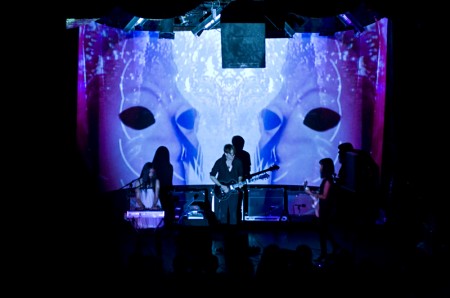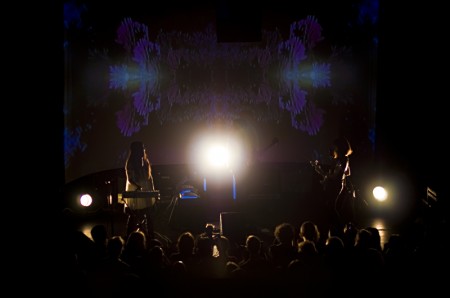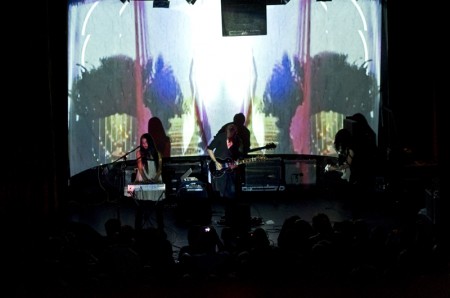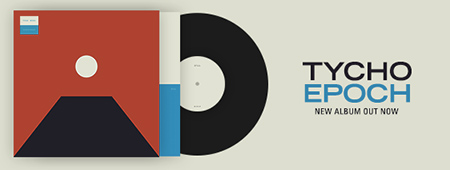Saccenti’s visuals for School of 7 Bells



You may know Tim Saccenti for his unreal spacey Battles video or his wild Animal Collective videos or press photos for Flying Lotus and Jimmy Edgar but his live visuals this weekend for School of Seven Bells were jaw dropping, not only did School of Seven Bells play a gorgeous live show but Tim Saccenti nailed the visuals and captured the sound perfectly, I almost felt like I was experiencing something that was on some other level. Below is a great review of the night:
Digital Transcendentalism
Timothy Saccenti’s Visuals andthe School of Seven Bells
The question that immediately comes to mind as one looks into the silky black voids of photographer/director Timothy Saccenti’s mind, manifested wonderfully in images of black expanses occupied ironically by an artist or an object beyond one’s capacity for reaction, is this: What possible world am I occupying and how am I existing in this space and time? With the School of Seven Bell’s visuals, Saccenti (in conjuction with Flame artist Alvin Cruz) achieves, brilliantly and originally, the apex of what all artists can hope to achieve; as the mirrored yet chaotic colors begin to rise up on the screen, the viewer relinquishes control of his or her consciousness of the moment and enters the beautiful, black, colorful, numbing minds of Saccenti and Cruz.
So what makes these images so otherworldly yet familiar enough that one can fall into them so whole-heartedly? The peice mixes familiar epiphenomenal stimuli (shapes and images) with powerful digital distortion, creating a space that is paradoxically common and foreign. The experience places the viewer at the precipice of human comprehension and tethers them to the rock of humanity with fibers so inconspicuous that it is hard to know when one might fall into the black abyss. It is exhilarating. Paired with the ambient, submissive music of The School of Seven Bells, an audience is treated to complete perceptual experience involving the lyrical mastery of the band and their interstellar sound.
There is a diamond shape that occupies the screen for much of the piece. Besides being a spatial image that one can clearly identify, it suggests another, semi-erotic, human form that boldly stares back at a transfixed audience. It is difficult not to see a vaginal, pink shape in the diamond. It is natural and digital, surrounded by a hazy distortion and heavy digital sounds that are reminiscent of television snow. Watching the two female singers, it is hard not to feel lulled by a kind of siren song.
One of the more powerful images, a white face with dark eyes, exists as a kind of character throughout the piece. It comes and goes as the viewer’s ability to make it out is realized and lost. The face is mirrored on both sides of the screen as one’s own face so commonly is. The face swings back and forth with an organic fluidity that is imperfectly natural and correct. Amongst the computerized movement of box shapes and spheres, this face stands out with its organic movement that, at the apex of its swing, faces the audience and becomes black (with white eyes). It is an eerie and fantastic moment as the echoing voices of The School of Seven Bells rise and fall to the metronome of the huge face.
The image that most dramatically drives the feeling of nature is the wilderness at sunrise; however, in digitally transcendental fashion, the piece juxtaposes the desert grasses with outstanding digital effects. The sunrise image sits inside a sphere that seems to rotate as the image remains still. The sphere fits inside the skeleton of a neon cube in an eclectic picture that moves with a more perfect, digital, fluidity. The circle is also seen in another major part of the piece. Inside of a large, white circle are numbers that follow around the circle’s circumference, similarly to that of an ancient calendar. Here, Saccenti seems to be exploring the most seamless connections between man and nature. Time is a human invention developed to understand the most fundamental engine of nature. It is a similar idea that drives the image of the Hindu deity, Ganesh. Here, the audience explores the human invention of religion as a tool for understanding the impossibilities of nature. A statue of the deity rotates slowly, giving a reverend importance to his presence.
The pairing of these two artists could not have been more perfect. The School of Seven Bells creates an original sound using a similar juxtaposition. Soft voices and flowing guitar riffs round out the heavy digital sound that backs up each song. These two elements collide to produce a sound that is otherworldly.
Throughout the piece, we see the majesty of nature and the boundless imagination of humanity. Represented beautifully by digital displays, the viewer enters a possible world that can only exist with the imagination of this brilliant collaboration, through the conduit that is their talent.
– Steven Graf

Comments are closed.